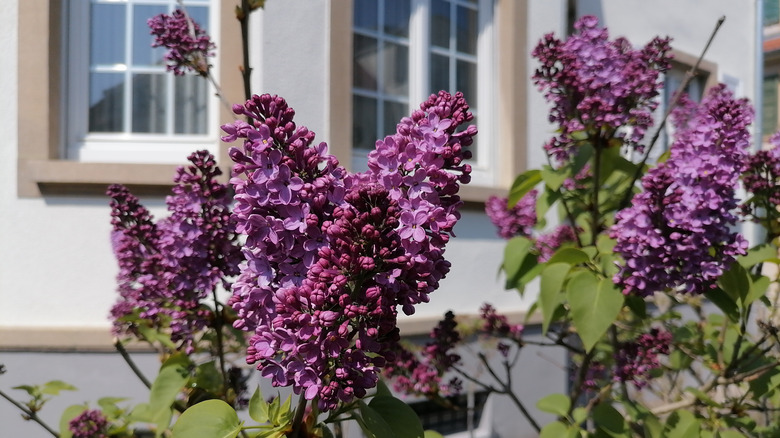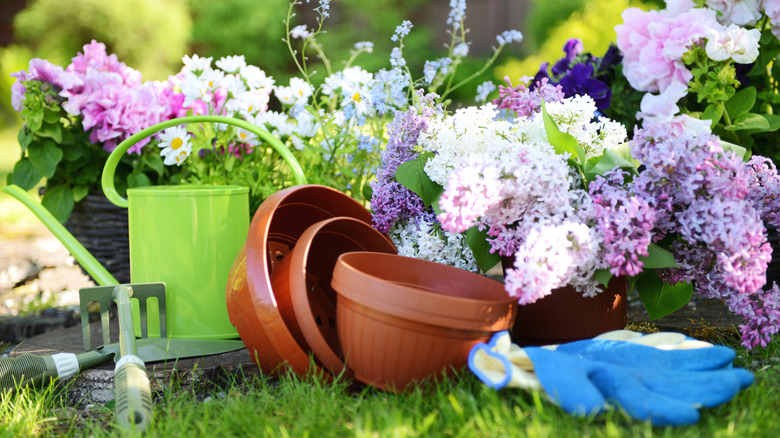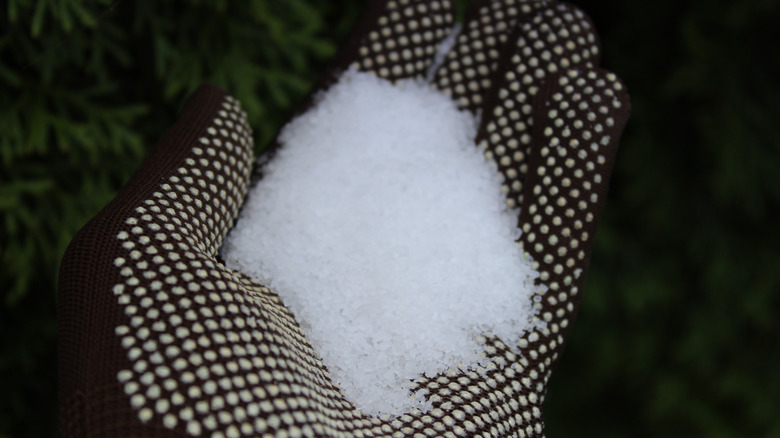Get Your Lilac Bush Blooming With A Common Household Staple
A bush that's full, lush, and green with foliage is healthy, right? But when it comes to lilac bushes (such as Syringa vulgaris, also known as common lilac), if it isn't teeming with fragrant namesake blossoms, what's the point? Lilacs are grown because those who plant them want to enjoy the beautiful flowers they produce. If your perennial has been lagging, you may be able to get your lilac bush blooming by treating it to a dose of a common household staple: Epsom salts.
For generations, gardeners have talked about the value of the chemical compound magnesium sulfate, which we know as Epsom salts. They have touted its use in dusting garden soil when planting seedlings or dissolving the substance in water and sprinkling it on plants during the growing season. Anecdotes abound among families and friends, in garden centers, over backyard fences, and in online chats. For pepper lovers, adding it to newly planted sprouts will help them bloom more robustly. The National Gardening Association did a trial with six test gardeners, and while there was some variance regarding the outcomes of using Epsom salts, everyone seemed to agree that before reaching for the mineral or adding any amendments, a soil test should be done.
Soil testing is key to getting the right fertilizers and nutrients to your lilac bushes. Just like a sprinkle of baking soda will have lilacs and other popular garden flowers blooming like crazy, Epsom salts could do the same thing for lilacs. If your soil needs it, the magnesium-based compound might make a big difference.
Epsom salts' secret weapon: magnificent magnesium and how to apply it
To get your lilac bush blooming, you'll need to understand what's happening below the surface, which means understanding what is happening in the soil. No matter what you're growing, you can maximize your garden's production by using a simple glass jar soil test, which will let you know your soil composition (like clay or sand) and thus its drainage. Follow that up with a soil test for important nutrient information so you know if your lilac will benefit from a boost in magnesium. Low magnesium is noticeable when leaves fall off bushes and trees too early, and look crumbly or weak. Luckily, using Epsom salts as a soil amendment is a great way to add this nutrient.
Once you feel confident that your lilac is craving magnesium, you'll need to know how to best apply it. There are two methods: dry and wet. For the dry method, dust about 1 cup's worth of Epsom salts near your lilac when it's dormant (during the cold season) — around the soil that encircles the shrub. Then, work the mineral into the top layer of dirt using a trowel, hoe, or rake. For the watering method, add 1 to 2 tablespoons of Epsom salts to a gallon of water and spray your lilac bushes once a month during dormancy with the solution.
Other things to note about using Epsom salt on lilacs
Lilac fans will say there are endless reasons to love them because there are over 1,600 cultivars of this popular shrub. Give the bushes extra love with treatments like Epsom salts or fertilizers, if needed. Add amendments during the dormant period, during planting, or after a soil test determines you have a magnesium deficiency.
Be careful, though, because your perennial might surprise you with an extra blossoming! If conditions are just right, the normally spring showstopper could flower again. You might ask, should my lilac plants bloom again in the fall? Blooming again diverts energy away from preparing the bush for the next season, robbing it of the ability to give you as many blossoms in the spring. Don't add Epsom salts or fertilizer in that instance.
Try to identify the cause of the second blooming to prevent it from happening again. If it's because there was a heat wave or too little rain, take good care to protect your plants going forward. If a fungus like Pseudocercospora is to blame, dispose of plant material that came in contact with the spores (stems, roots, flowers, and leaves, including those that have fallen). Gardening can be tough. When the rakes and watering cans have been put away, Epsom salts can help you one more time — especially if you have a magnesium deficiency in the soil around your lilacs.


